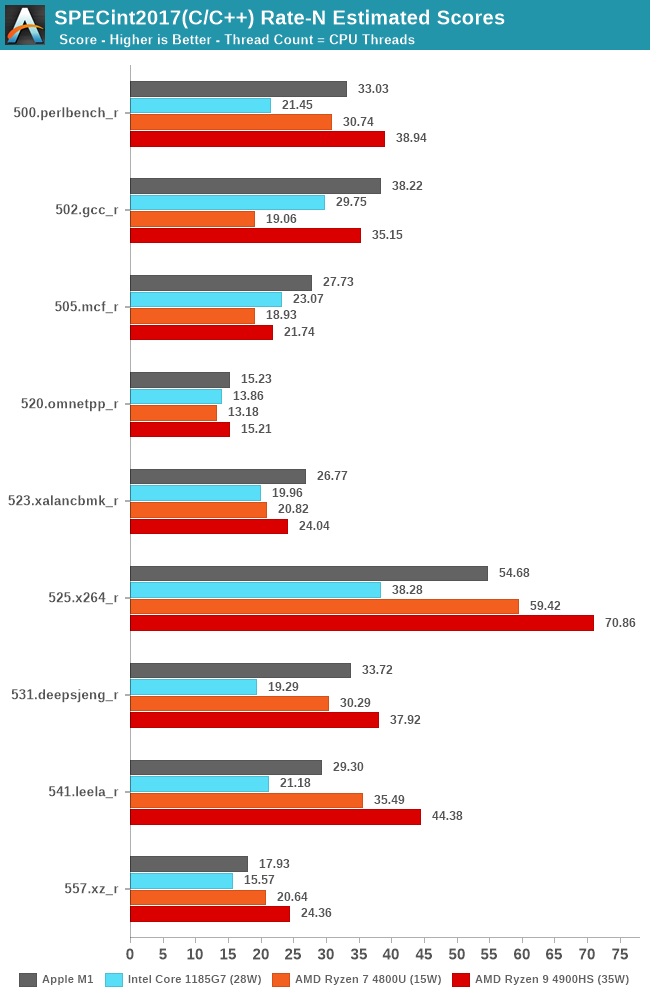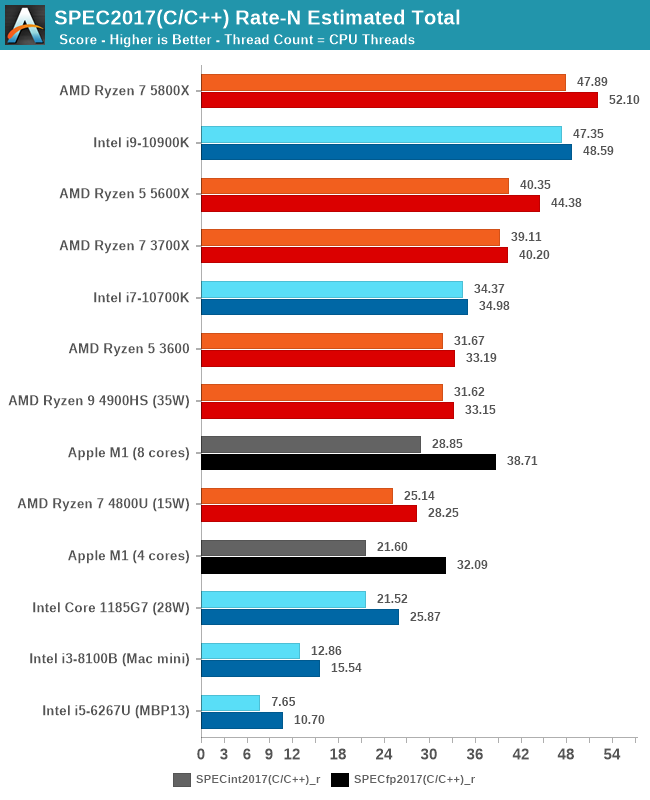The 2020 Mac Mini Unleashed: Putting Apple Silicon M1 To The Test
by Andrei Frumusanu on November 17, 2020 9:00 AM ESTSPEC2017 - Multi-Core Performance
While we knew that the Apple M1 would do extremely well in single-threaded performance, the design’s strengths are also in its power-efficiency which should directly translate to exceptionally good multi-threaded performance in power limited designs. We noted that although Apple doesn’t really publish any TDP figure, we estimate that the M1 here in the Mac mini behaves like a 20-24W TDP chip.
We’re including Intel’s newest Tiger Lake system with an i7-1185G7 at 28W, an AMD Ryzen 7 4800U at 15W, and a Ryzen 9 4900HS at 35W as comparison points. It’s to be noted that the actual power consumption of these devices should exceed that of their advertised TDPs, as it doesn’t account for DRAM or VRMs.

In SPECint2017 rate, the Apple M1 battles with AMD’s chipsets, with the results differing depending on the workload, sometimes winning, sometimes losing.

In the fp2017 rate results, we see similar results, with the Apple M1 battling it out with AMD’s higher-end laptop chip, able to beat the lower TDP part and clearly stay ahead of Intel’s design.

In the overall multi-core scores, the Apple M1 is extremely impressive. On integer workloads, it still seems that AMD’s more recent Renoir-based designs beat the M1 in performance, but only in the integer workloads and at a notably higher TDP and power consumption.
Apple’s lead against Intel’s Tiger Lake SoC at 28W here is indisputable, and shows the reason as to why Apple chose to abandon their long-term silicon partner of 15 years. The M1 not only beats the best Intel has to offer in this market-segment, but does so at less power.
I also included multi-threaded scores of the M1 when ignoring the 4 efficiency cores of the system. Here although it’s an “8-core” design, the heterogeneous nature of the CPUs means that performance is lop-sided towards the big cores. That doesn’t mean that the efficiency cores are absolutely weak: Using them still increases total throughput by 20-33%, depending on the workload, favouring compute-heavy tasks.
Overall, Apple doesn’t just deliver a viable silicon alternative to AMD and Intel, but actually something that’s well outperforms them both in absolute performance as well as power efficiency. Naturally, in higher power-level, higher-core count systems, the M1 can’t keep up to AMD and Intel designs, but that’s something Apple likely will want to address with subsequent designs in that category over the next 2 years.










682 Comments
View All Comments
Ppietra - Tuesday, November 24, 2020 - link
Sorry, but no! What you showed for the 4800U isn’t the power draw of the computer, it’s the power draw of a processor doing a completely different test in an unnamed computer in unknown settings. Not to mention that this M1 analysis is with a desktop computer not a laptop. Why are you trying to deceive?If you want to see computer power consumption go to Tally Ho Tech youtube channel, you will see how a laptop with the 4800U consumes around 3 times more in Cinebench than a laptop with a M1 chip.
BushLin - Tuesday, November 24, 2020 - link
Oh... I have to wade through some random YouTube channel to see some other flawed comparison? If you can link to an objective test showing actual power draw, post the link.Ppietra - Tuesday, November 24, 2020 - link
hmmm! So you complain about a channel doing a straightforward comparison in similar conditions, but you have no problems in using different kinds of power consumption from completely different tests to validate your "theory". Grand!!For the record thunng8 links shows you the power consumption of the M1 in a Cinebench test done by Anandtech’ author.
BushLin - Tuesday, November 24, 2020 - link
No, I'm continuing to complain that you don't post a link to your evidence, I'm not sitting through every YouTube video of some random when in the next breath you refer again to a forum post linked by thunng8 which is for a different, 4700U CPU.No amount of FUD changes the fact that the M1 is great at single thread, especially for the power but isn't the Jesus CPU you dream it to be in multithreaded workloads.
Put up or shut up.
Ppietra - Tuesday, November 24, 2020 - link
I have said nothing about a 4700U CPU nor referred to links to talk about AMD CPUs. I very clearly only mentioned M1 data when referring to thunng8 links. Neither have I said that the M1 had the highest performance of all, I only talked about power consumption.https://www.youtube.com/watch?v=wuvZQOUDCKY
BushLin - Tuesday, November 24, 2020 - link
Great YouTube video, didn't measure the power draw. Yet you're the one throwing around words like deceive.Ppietra - Tuesday, November 24, 2020 - link
Didn’t measure the power draw? Really?So showing battery level change after 10 minute Cinebench test, with known battery capacities, isn’t sufficient data to determine approximate power draw? Not even enough to give you an idea? A little bit of basic math, then!
16% drop in a 60.7Wh battery gives 9.7Wh of energy use for the AMD laptop. If you prefer in watts, since it was a 10 minute run that gives 58W.
6% drop in a 58Wh battery gives 3.5Wh of energy used for the MacBook Pro. In a 10 minute run that gives 21W, to do the same task.
From a previous video the Cinebench MT scores were 9976 for AMD and 7800 for the MacBook.
If you normalize energy consumption to the Cinebench score, that would mean the MacBook Pro consumes less than half for the same performance!
BushLin - Tuesday, November 24, 2020 - link
What are the cinebench results when running on battery? What is the battery's actual capacity and how fast does it drain when fully loaded? How does the system report battery percentage vs voltage of the cells? How much power does the screen consume? Can you trust the person making the video to be thorough and objective?Could go on and on, or just stick a $15 meter on the AC plug and actually measure it.
Ppietra - Tuesday, November 24, 2020 - link
?? I gave you the Cinebench results. I gave the actual battery capacity, I gave how much it drained when running Cinebench and in what time interval - it is all in the videos!How much power does the screen consume??? REALLY!!!? For someone who argued for the use of "power measurement" "at the wall rather than just the SoC " to now come and argue against measuring the battery power drain in a 10 minutes test it is laughable. Even more so when in the end you make another U turn and just argue about measuring power at the plug - so the screen doesn’t matter now!??
Just face reality M1 power consumption has been measured at 15W in Cinebench, by Anandtech. 4800U power consumption can go higher than 25W since it can be boosted to 35W.
BushLin - Tuesday, November 24, 2020 - link
Since you're either a troll or insane, I'm not going to expend any further effort beyond answering this:"Just face reality M1 power consumption has been measured at 15W in Cinebench, by Anandtech"
With this:
https://images.anandtech.com/graphs/graph16252/119...